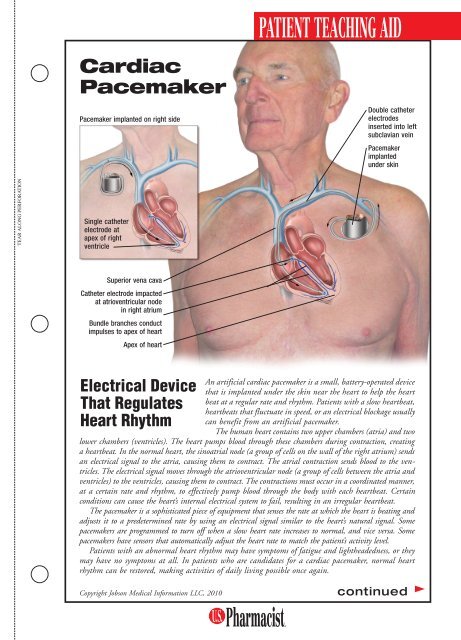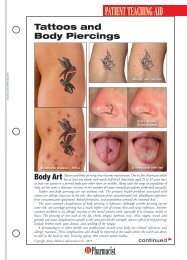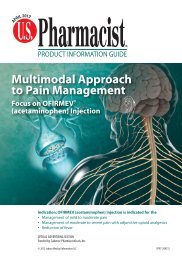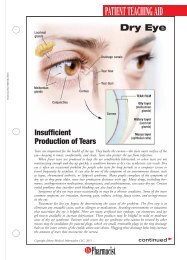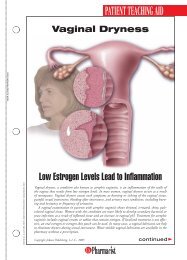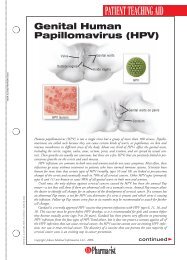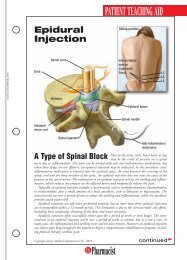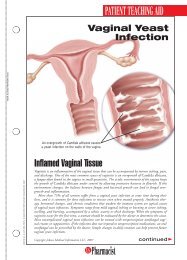Cardiac Pacemaker pdf - U.S. Pharmacist
Cardiac Pacemaker pdf - U.S. Pharmacist
Cardiac Pacemaker pdf - U.S. Pharmacist
Create successful ePaper yourself
Turn your PDF publications into a flip-book with our unique Google optimized e-Paper software.
<strong>Cardiac</strong><strong>Pacemaker</strong><strong>Pacemaker</strong> implanted on right sidePATIENT TEACHING AIDDouble catheterelectrodesinserted into leftsubclavian vein<strong>Pacemaker</strong>implantedunder skinTEAR ALONG PERFORATIONSingle catheterelectrode atapex of rightventricleSuperior vena cavaCatheter electrode impactedat atrioventricular nodein right atriumBundle branches conductimpulses to apex of heartApex of heartElectrical DeviceThat RegulatesHeart RhythmAn artificial cardiac pacemaker is a small, battery-operated devicethat is implanted under the skin near the heart to help the heartbeat at a regular rate and rhythm. Patients with a slow heartbeat,heartbeats that fluctuate in speed, or an electrical blockage usuallycan benefit from an artificial pacemaker.The human heart contains two upper chambers (atria) and twolower chambers (ventricles). The heart pumps blood through these chambers during contraction, creatinga heartbeat. In the normal heart, the sinoatrial node (a group of cells on the wall of the right atrium) sendsan electrical signal to the atria, causing them to contract. The atrial contraction sends blood to the ventricles.The electrical signal moves through the atrioventricular node (a group of cells between the atria andventricles) to the ventricles, causing them to contract. The contractions must occur in a coordinated manner,at a certain rate and rhythm, to effectively pump blood through the body with each heartbeat. Certainconditions can cause the heart’s internal electrical system to fail, resulting in an irregular heartbeat.The pacemaker is a sophisticated piece of equipment that senses the rate at which the heart is beating andadjusts it to a predetermined rate by using an electrical signal similar to the heart’s natural signal. Somepacemakers are programmed to turn off when a slow heart rate increases to normal, and vice versa. Somepacemakers have sensors that automatically adjust the heart rate to match the patient’s activity level.Patients with an abnormal heart rhythm may have symptoms of fatigue and lightheadedness, or theymay have no symptoms at all. In patients who are candidates for a cardiac pacemaker, normal heartrhythm can be restored, making activities of daily living possible once again.Copyright Jobson Medical Information LLC, 2010continued
PATIENT TEACHING AIDInform Health Care ProfessionalsThat You Have a <strong>Pacemaker</strong>Individuals who have an irregular heartbeat and symptoms suchas fatigue, fainting, and shortness of breath may benefit froman artificial cardiac pacemaker. Tests performed to determinewhether a pacemaker would be helpful may include an electrocardiogram(ECG), a Holter monitor to record the heart’selectrical activity over 1 to 2 days, an echocardiogram to assesshow well the heart pumps blood, a stress test to determine howwell the heart works during exercise, or an electrophysiologicstudy to check the heart’s electrical system.This device senses the heart’s rateand rhythm and transmits anelectrical impulse to normalizean abnormal heartbeat.What Is a <strong>Pacemaker</strong> and How Does It Work?An artificial cardiac pacemaker is a small, battery-run, programmable device with one or more leadwires that attach to the heart wall. The lead wires carry signals from the heart to the pacemaker,which determines from the signals when to send electrical impulses to pace the heart.The device is surgically implanted under the skin, usually near the left side of the chest by thecollarbone. Local anesthesia is used during surgery, and the patient is kept overnight to confirmthat the equipment is working correctly. The procedure is safe and has few complications. Anymild pain or swelling of the site may be treated with nonprescription pain medications. Patientsare instructed to avoid activities such as heavy lifting or strenuous exercise for a few weeks aftersurgery to prevent the pacemaker or lead wires from dislodging.The pacemaker senses the heart’s rate and rhythm and transmits an electrical impulse to restorethe heartbeat to normal. One type of pacemaker, called a demand pacemaker, transmits an impulsewhen the heart beats too slowly or skips a beat, but turns itself off when the heart is beating normally.Rate-responsive pacemakers can sense a person’s activity level at any given time and adjuststhe heart rate accordingly.Regular <strong>Pacemaker</strong> Checks Are ImportantOnce a pacemaker is implanted, it must be checked regularly to be sure it is working properly.One method is to use a programming device that is held over the location of the pacemaker. Theprogramming device can also change the settings on the pacemaker, if necessary. <strong>Pacemaker</strong> activityalso can be checked by telephone with special equipment; however, regular visits to the cardiologistare still necessary.<strong>Pacemaker</strong> batteries last up to 15 years before replacement is required. During replacementsurgery, the pacemaker is replaced, but the lead wires are usually left in place. Eventually, the leadwires also may need to be replaced.Avoid Exposure to Certain EquipmentA person with an artificial cardiac pacemaker should avoid close exposure to equipment that canaffect its performance. A patient receiving a pacemaker should be given a list of devices to avoid,such as MRI machines, radiation machines for cancer treatment, dental equipment, and generators.Many electronic devices are safe to use around a pacemaker. Currently available cellular phonesand MP3 players usually can be used, but they should not be stored in a shirt pocket, and whenin use they should be held on the opposite side of the chest at least 6 inches from the pacemaker.This recommendation should be checked with the cardiologist who implanted the pacemaker.Patients should always tell their doctors, dentists, and health care technicians that they have apacemaker; they also should carry a card identifying the type of pacemaker implanted.


